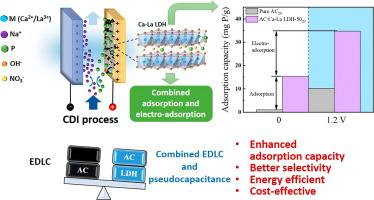Capacitive deionization exploiting La-based LDH composite electrode toward energy efficient and selective removal of phosphate
IF 8.3
1区 工程技术
Q1 ENGINEERING, CHEMICAL
引用次数: 0
Abstract
Capacitive deionization (CDI) is a promising technology for removing phosphate from wastewater. Its practical implementation is however hindered by the constraints on the electrode materials. To boost the adsorption capacity, phosphate selectivity, and cost-effectiveness of the electrode, this study proposed a composite electrode blending Lanthanum-based layered double hydroxide (Ca-La LDH) and activated carbon (AC). It capitalizes on the synergistic effects of electric double layer capacitance (EDLC) of AC and the diffusion-controlled charge storage (pseudocapacitive behavior) of Ca-La LDH. By optimizing the mass ratios of the constituents and the electrode material loading capacities, the composite electrode AC/Ca-La LDH-5020 was developed, which contains 20 mg of 50 wt% Ca-La LDH. This composition achieved a remarkable phosphate adsorption capacity of 34.8 mg P /g and a low energy consumption of 0.0051 kWh/g P in constant voltage (CV) mode. It represented a 241 % increase in adsorption capacity (mg P/g) and 71 % decrease in specific energy consumption (kWh/g P) compared to the electrode made solely of AC. Particularly the moderate inclusion of Lanthanum contributes to its cost-effectiveness. Moreover, further studies extensively examined the impacts of electrical driving force, including applied voltage in constant voltage (CV) mode and applied current in constant current (CC) mode, on the phosphate removal efficiency. The composite electrode remained stable performance with the presence of the high content of coexisting anions (e.g.,Cl−,SO42−, HCO3−, NO3−), obtaining high selectivity coefficient of phosphate over other anions. This study highlighted the practical potential of AC/Ca-La LDH composite electrode for advancing CDI technology for phosphate removal in an efficient, energy-saving and cost-effective manner.

利用 La 基 LDH 复合电极的电容式去离子技术,实现高效节能和选择性去除磷酸盐
电容式去离子技术(CDI)是一种很有前途的去除废水中磷酸盐的技术。然而,电极材料的限制阻碍了该技术的实际应用。为了提高电极的吸附能力、磷酸盐选择性和成本效益,本研究提出了一种混合镧系双层氢氧化物(Ca-La LDH)和活性炭(AC)的复合电极。它充分利用了 AC 的双电层电容(EDLC)和 Ca-La LDH 的扩散控制电荷存储(伪电容行为)的协同效应。通过优化各成分的质量比和电极材料的负载能力,开发出了 AC/Ca-La LDH-5020 复合电极,其中含有 20 毫克 50 wt% 的 Ca-La LDH。在恒压(CV)模式下,这种成分的磷酸盐吸附容量高达 34.8 毫克 P/g,能耗低至 0.0051 千瓦时/克 P。与完全由交流电制成的电极相比,吸附容量(毫克磷/克)提高了 241%,比能耗(千瓦时/克磷)降低了 71%。镧的适度加入尤其有助于提高其成本效益。此外,进一步的研究还广泛考察了电驱动力(包括恒压(CV)模式下的施加电压和恒流(CC)模式下的施加电流)对磷酸盐去除效率的影响。在共存阴离子(如 Cl-、SO42-、HCO3-、NO3-)含量较高的情况下,复合电极仍能保持稳定的性能,对磷酸盐的选择性系数高于其他阴离子。这项研究凸显了 AC/Ca-La LDH 复合电极在推动 CDI 技术以高效、节能和经济的方式去除磷酸盐方面的实用潜力。
本文章由计算机程序翻译,如有差异,请以英文原文为准。
求助全文
约1分钟内获得全文
求助全文
来源期刊

Desalination
工程技术-工程:化工
CiteScore
14.60
自引率
20.20%
发文量
619
审稿时长
41 days
期刊介绍:
Desalination is a scholarly journal that focuses on the field of desalination materials, processes, and associated technologies. It encompasses a wide range of disciplines and aims to publish exceptional papers in this area.
The journal invites submissions that explicitly revolve around water desalting and its applications to various sources such as seawater, groundwater, and wastewater. It particularly encourages research on diverse desalination methods including thermal, membrane, sorption, and hybrid processes.
By providing a platform for innovative studies, Desalination aims to advance the understanding and development of desalination technologies, promoting sustainable solutions for water scarcity challenges.
 求助内容:
求助内容: 应助结果提醒方式:
应助结果提醒方式:


